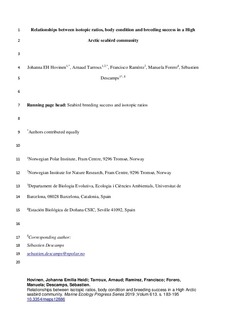| dc.contributor.author | Hovinen, Johanna Emilia Heidi | |
| dc.contributor.author | Tarroux, Arnaud | |
| dc.contributor.author | Ramirez, Francisco | |
| dc.contributor.author | Forero, Manuela | |
| dc.contributor.author | Descamps, Sébastien | |
| dc.coverage.spatial | Svalbard | nb_NO |
| dc.date.accessioned | 2019-10-03T12:03:02Z | |
| dc.date.available | 2019-10-03T12:03:02Z | |
| dc.date.issued | 2019 | |
| dc.identifier.issn | 0171-8630 | |
| dc.identifier.uri | http://hdl.handle.net/11250/2620082 | |
| dc.description.abstract | Predators such as seabirds are often used as bio-indicators of the marine environment. This is based on the assumption that changes in seabird populations are driven by changes in their prey. We tested this assumption in a High Arctic seabird community by assessing the relationships between the diet, body condition, and breeding performance of 4 ecologically different species: the little auk Alle alle, black-legged kittiwake Rissa tridactyla, Brünnich’s guillemot Uria lomvia, and glaucous gull Larus hyperboreus, breeding in Svalbard, Norway. Interannual changes in seabird diet (2009−2015) were assessed by estimating their carbon and nitrogen isotopic ratios (δ15N and δ13C) during the breeding and non-breeding seasons (i.e. using blood and feather tissues). We found interannual variation in the isotopic ratios during both seasons in all 4 species. These variations differed among species, thus suggesting dietary changes, instead of changes in isotopic baselines, as the most plausible mechanism underlying such patterns. We also found that seabirds had a lower average hatching success when the average δ15N during the previous nonbreeding season was higher. Our results suggest that changes in the average prey composition during the non-breeding season may partially explain changes in breeding performance of Svalbard seabirds. | nb_NO |
| dc.language.iso | eng | nb_NO |
| dc.subject | Diet | nb_NO |
| dc.subject | Marine birds | nb_NO |
| dc.subject | Svalbard | nb_NO |
| dc.subject | Carry-over effects | nb_NO |
| dc.subject | Reproductive output | nb_NO |
| dc.subject | Stable isotopes | nb_NO |
| dc.subject | Trophic level | nb_NO |
| dc.subject | Nitrogen | nb_NO |
| dc.subject | Carbon | nb_NO |
| dc.title | Relationships between isotopic ratios, body condition and breeding success in a High Arctic seabird community | nb_NO |
| dc.type | Peer reviewed | nb_NO |
| dc.type | Journal article | |
| dc.description.version | acceptedVersion | nb_NO |
| dc.rights.holder | © Inter-Research 2019 · www.int-res.com | nb_NO |
| dc.subject.nsi | VDP::Matematikk og Naturvitenskap: 400::Zoologiske og botaniske fag: 480 | nb_NO |
| dc.source.pagenumber | 183-195 | nb_NO |
| dc.source.volume | 613 | nb_NO |
| dc.source.journal | Marine Ecology Progress Series | nb_NO |
| dc.identifier.doi | 10.3354/meps12886 | |
| dc.identifier.cristin | 1699806 | |
